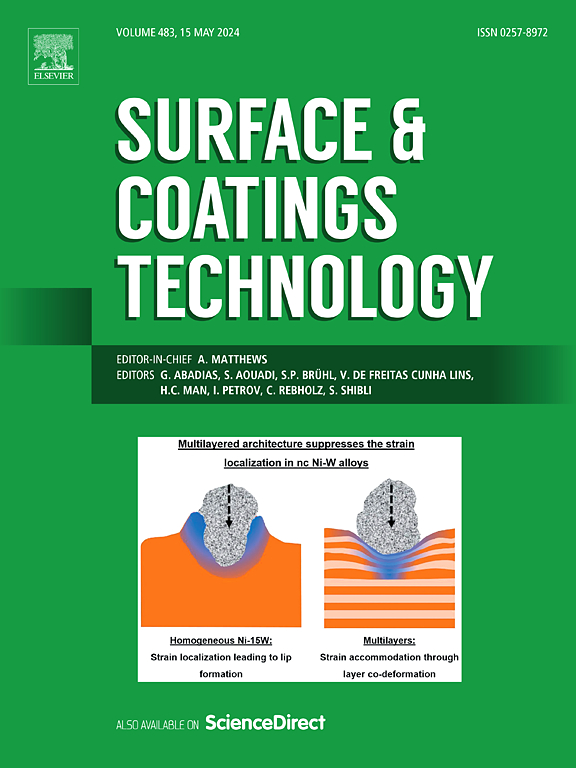Mo掺入对TiAlN涂层组织、力学性能、热稳定性和抗氧化性的影响
IF 6.1
2区 材料科学
Q1 MATERIALS SCIENCE, COATINGS & FILMS
引用次数: 0
摘要
在TiAlN涂层中添加过渡金属形成季系合金是改善涂层性能的有效途径。本文研究了mo对TiAlN涂层结构和性能的影响。Ti1-x-yAlyMoxN(0≤x≤0.12,y = 0.53, 0.54)涂层呈现单相fcc结构。Mo与TiAlN的掺入使TiAlN的硬度从Ti0.46Al0.54N的30.0±0.5 GPa略微提高到Ti0.34Al0.54Mo0.12N的31.4±0.9 GPa。此外,mo的加入提高了TiAlN涂层的热稳定性,使其分解和w-AlN析出的起始温度提高了~100℃。从头计算和实验结果均表明Ti1-x-yAlyMoxN的优先分解路径为TiMoN + AlN。因此,将Mo合金化到TiAlN涂层中可以获得更强的时效硬化能力。此外,mo的加入抑制了a- tio2的生成,促进了α-Al2O3的生成,从而提高了材料的抗氧化性。850℃氧化10 h后,Ti0.45Al0.54Mo0.01N、Ti0.39Al0.54Mo0.07N和Ti0.34Al0.54Mo0.12N镀层的氧化膜厚度分别为~2.7、2.0和1.0 μm,而Ti0.46Al0.54N镀层则完全氧化。本文章由计算机程序翻译,如有差异,请以英文原文为准。
Effect of Mo incorporation on the structure, mechanical properties, thermal stability and oxidation resistance of TiAlN coatings
Alloying with an additional transition metal into TiAlN coating to develop a quaternary system is an effective approach to improve the properties. Here, the effect of Mo-addition on the structure and properties of TiAlN coating is investigated. The Ti1-x-yAlyMoxN (0 ≤ x ≤ 0.12 and y = 0.53, 0.54) coatings exhibit a single-phase fcc structure. The incorporation of Mo into TiAlN leads to a slight increase in hardness from 30.0 ± 0.5 GPa for Ti0.46Al0.54N to 31.4 ± 0.9 GPa for Ti0.34Al0.54Mo0.12N. Also, the thermal stability of TiAlN coating is improved by the Mo-addition, where the onset temperatures of spinodal decomposition and w-AlN precipitation are increased by ~100 °C. Both ab initio calculation and experimental results suggest that the preferred decomposition path of Ti1-x-yAlyMoxN is TiMoN + AlN. Therefore, alloying with Mo into TiAlN coating induces a stronger age-hardening ability. Furthermore, the Mo-addition has a beneficial effect on the oxide resistance by suppressing a-TiO2 generation and promoting α-Al2O3 formation. After oxidation at 850 °C for 10 h, the Ti0.45Al0.54Mo0.01N, Ti0.39Al0.54Mo0.07N and Ti0.34Al0.54Mo0.12N coatings present oxide scale thickness of ~2.7, 2.0 and 1.0 μm, respectively, whereas Ti0.46Al0.54N coatings are fully oxidized.
求助全文
通过发布文献求助,成功后即可免费获取论文全文。
去求助
来源期刊

Surface & Coatings Technology
工程技术-材料科学:膜
CiteScore
10.00
自引率
11.10%
发文量
921
审稿时长
19 days
期刊介绍:
Surface and Coatings Technology is an international archival journal publishing scientific papers on significant developments in surface and interface engineering to modify and improve the surface properties of materials for protection in demanding contact conditions or aggressive environments, or for enhanced functional performance. Contributions range from original scientific articles concerned with fundamental and applied aspects of research or direct applications of metallic, inorganic, organic and composite coatings, to invited reviews of current technology in specific areas. Papers submitted to this journal are expected to be in line with the following aspects in processes, and properties/performance:
A. Processes: Physical and chemical vapour deposition techniques, thermal and plasma spraying, surface modification by directed energy techniques such as ion, electron and laser beams, thermo-chemical treatment, wet chemical and electrochemical processes such as plating, sol-gel coating, anodization, plasma electrolytic oxidation, etc., but excluding painting.
B. Properties/performance: friction performance, wear resistance (e.g., abrasion, erosion, fretting, etc), corrosion and oxidation resistance, thermal protection, diffusion resistance, hydrophilicity/hydrophobicity, and properties relevant to smart materials behaviour and enhanced multifunctional performance for environmental, energy and medical applications, but excluding device aspects.
 求助内容:
求助内容: 应助结果提醒方式:
应助结果提醒方式:


